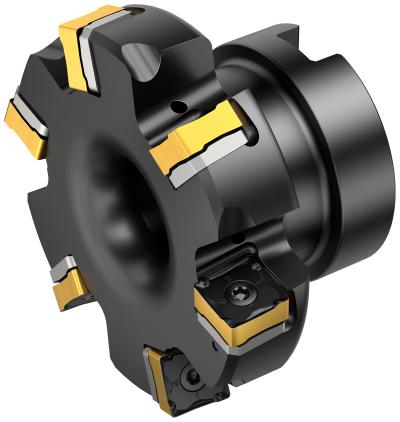
Global metal-cutting leader Sandvik Coromant is expanding its milling offering with the new CoroMill® MF80 for automotive milling applications in ISO K and ISO P materials in close to 90-degree operations with fixture constraints.
Based on a technology platform similar to the existing CoroMill® 345, this new milling concept offers a 40 percent lighter cutter body with shim protection and a high number of inserts for secure and stable machining, even in vibration-prone overhang applications. The 89.5-degree approach angle enables the multi-edge cutter to work close to the fixture, which not only greatly improves machine utilization, but also ensures a longer tool life with less scrap.
The inserts have eight cutting edges, chip protection and optimized micro geometry for better security and chip evacuation, as well as a wiper edge for a superior surface finish. The cutting edge is inclined for smooth cutting action and low cutting forces, making it ideal for thin-walled components and machine setups with limited stability.
In a roughing shoulder milling performance test with a competing brand, the CoroMill® MF80 showed a remarkable 67 percent increase in tool life, which, in turn, boosted overall productivity by 60 percent. After 40 minutes of machining, the comparison ended with 15 freshly machined components for Sandvik Coromant and 9 for the competitor. The shim protection and high number of insert edges effectively lowered cost per part in this roughing application.
Contact Details
Related Glossary Terms
- approach angle
approach angle
Angle between the insert’s side-cutting edge and the line perpendicular to the milling cutter’s axis of rotation. Approach angle, which is also known as cutting edge angle, is used with metric units of measurement. See lead angle.
- fixture
fixture
Device, often made in-house, that holds a specific workpiece. See jig; modular fixturing.
- gang cutting ( milling)
gang cutting ( milling)
Machining with several cutters mounted on a single arbor, generally for simultaneous cutting.
- milling
milling
Machining operation in which metal or other material is removed by applying power to a rotating cutter. In vertical milling, the cutting tool is mounted vertically on the spindle. In horizontal milling, the cutting tool is mounted horizontally, either directly on the spindle or on an arbor. Horizontal milling is further broken down into conventional milling, where the cutter rotates opposite the direction of feed, or “up” into the workpiece; and climb milling, where the cutter rotates in the direction of feed, or “down” into the workpiece. Milling operations include plane or surface milling, endmilling, facemilling, angle milling, form milling and profiling.
- wiper
wiper
Metal-removing edge on the face of a cutter that travels in a plane perpendicular to the axis. It is the edge that sweeps the machined surface. The flat should be as wide as the feed per revolution of the cutter. This allows any given insert to wipe the entire workpiece surface and impart a fine surface finish at a high feed rate.

